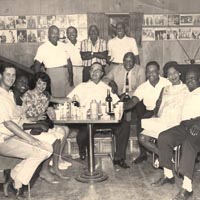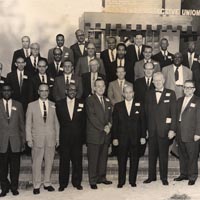
Ironically, during the 1960s, when African Americans across the country strove for integration, members of Local 627 chose to remain separate from the white Local 34. ![]() Luqman Hamza explained that "we had more work than members of 34. Around three quarters of our members had regular work."
Luqman Hamza explained that "we had more work than members of 34. Around three quarters of our members had regular work." ![]() Ahmad Alaadeen added that "we had all the county jobs and all the nightclubs." Members of 627 feared they would get short shrift on jobs if the two unions merged. They were also reluctant to give up their long-time headquarters that served as a clearing house for jobs as well as a social center, a place to jam, have a drink and play a quick game of dominos.
Ahmad Alaadeen added that "we had all the county jobs and all the nightclubs." Members of 627 feared they would get short shrift on jobs if the two unions merged. They were also reluctant to give up their long-time headquarters that served as a clearing house for jobs as well as a social center, a place to jam, have a drink and play a quick game of dominos.
In 1960, union members installed a lounge in the storage room behind the office, creating a comfortable ![]() social area with a bar and tables. The
social area with a bar and tables. The ![]() small bar manned by
small bar manned by ![]() Ernie Williams served members in good standing and their invited guests. Photos of current and past members ringed the walls. The lounge became a favored spot for rehearsals and jam sessions.
Ernie Williams served members in good standing and their invited guests. Photos of current and past members ringed the walls. The lounge became a favored spot for rehearsals and jam sessions. ![]() Willie Rice frequently rehearsed his big band in the lounge area.
Willie Rice frequently rehearsed his big band in the lounge area.
Visiting musicians often stopped by to jam in the lounge. President Smith reported in "The Rhythm Beat" how organist ![]() Jimmy Smith surprised a gathering crowd with his virtuosity—at the piano:
Jimmy Smith surprised a gathering crowd with his virtuosity—at the piano:
"Last Tuesday afternoon, 'Cleanhead' Vinson and ![]() Eddie Saunders came in the building with a very modest, unassuming youngster whom I failed completely to recognize. He nodded and passed thru into the lounge. 'Cleanhead' brought him back and without fanfare said, 'Jimmy, I want you to meet our 'Pres.' -- 'Pres.', this is Jimmy Smith.' I said 'Hi, Jimmy, just passing thru?' He said 'no, I'll be at the Mardi Gras another week.' I said 'oh, you're that Jimmy Smith?'" "The three of them returned to the lounge and 'Cleanhead' pulled out his horn to run over a few sounds with Jimmy....But he never quite got his horn out of the case. Jimmy started playing by himself, rather haphazardly at first, running thru his own innovations of what might have easily been the sound track of some outer space super cinerama production. Then for the next forty minutes he built a continuous symphonic paraphrase, running the gamut of every conceivable musical form. Reflections of Haydn, Liszt, Debussy and Brahms he carried in 5/4 time with his left hand while everything that Tatum and Peterson ever dreamed about came in 6/4, 9/8, 3/2 simultaneously from the strongest right hand ever seen or heard ... living or dead! Ask Willie Rice, Ask Eddie Saunders, Ask 'Cleanhead'!"
Eddie Saunders came in the building with a very modest, unassuming youngster whom I failed completely to recognize. He nodded and passed thru into the lounge. 'Cleanhead' brought him back and without fanfare said, 'Jimmy, I want you to meet our 'Pres.' -- 'Pres.', this is Jimmy Smith.' I said 'Hi, Jimmy, just passing thru?' He said 'no, I'll be at the Mardi Gras another week.' I said 'oh, you're that Jimmy Smith?'" "The three of them returned to the lounge and 'Cleanhead' pulled out his horn to run over a few sounds with Jimmy....But he never quite got his horn out of the case. Jimmy started playing by himself, rather haphazardly at first, running thru his own innovations of what might have easily been the sound track of some outer space super cinerama production. Then for the next forty minutes he built a continuous symphonic paraphrase, running the gamut of every conceivable musical form. Reflections of Haydn, Liszt, Debussy and Brahms he carried in 5/4 time with his left hand while everything that Tatum and Peterson ever dreamed about came in 6/4, 9/8, 3/2 simultaneously from the strongest right hand ever seen or heard ... living or dead! Ask Willie Rice, Ask Eddie Saunders, Ask 'Cleanhead'!"
Several years later, ![]() John Coltrane surprised Ahmad Alaadeen and other members by showing up at the union hall looking to hire a drummer for a date in town.
John Coltrane surprised Ahmad Alaadeen and other members by showing up at the union hall looking to hire a drummer for a date in town.
Local 627 thrived throughout the 1960s. The flourishing local blues and soul club scene brought new members to the union. Richard Smith and Carroll Jenkins carefully monitored club activity and brought non-union blues and soul musicians into the ranks of Local 627. Bluesmen ![]() Leon Estelle,
Leon Estelle, ![]() Alex Littlejohn (King Alex),
Alex Littlejohn (King Alex), ![]() Lawrence Wright and George Jackson reluctantly joined to gain access to union clubs. Texas blues guitarist
Lawrence Wright and George Jackson reluctantly joined to gain access to union clubs. Texas blues guitarist ![]() Albert Collins was a member of the union for a short while in 1966, while working with Estelle and Littlejohn.
Albert Collins was a member of the union for a short while in 1966, while working with Estelle and Littlejohn.
![]() Tommy and the Derby's, a soul review featuring
Tommy and the Derby's, a soul review featuring ![]() Marva Whitney, became members in the mid-1960s. Led by Tommy and James Gadson, the sons of drummer
Marva Whitney, became members in the mid-1960s. Led by Tommy and James Gadson, the sons of drummer ![]() Harold Gadson, the Derby's tooled around town in a hearse with a large Derby perched on top. James Gadson later went on to fame as a member of Dyke and the Blazers, Charles Wright and the Watts 103rd Street Rhythm Band and as an in-demand session musician. A number of other members including Ahmad Alaadeen,
Harold Gadson, the Derby's tooled around town in a hearse with a large Derby perched on top. James Gadson later went on to fame as a member of Dyke and the Blazers, Charles Wright and the Watts 103rd Street Rhythm Band and as an in-demand session musician. A number of other members including Ahmad Alaadeen, ![]() Larry Cummings,
Larry Cummings, ![]() Bettye Miller and Milt Abel toured nationally while maintaining their affiliation with Local 627.
Bettye Miller and Milt Abel toured nationally while maintaining their affiliation with Local 627.
Since the 1930s, Local 627 had resisted overtures to join forces with white Local 34. Finally, on April 1, 1970, the two unions were forced to merge by order of the national headquarters of the ![]() American Federation of Musicians, bringing to a close the glorious saga of Local 627, one of the longest, continuously-operating African American musicians unions in the country.
American Federation of Musicians, bringing to a close the glorious saga of Local 627, one of the longest, continuously-operating African American musicians unions in the country.


-200px.jpg)

